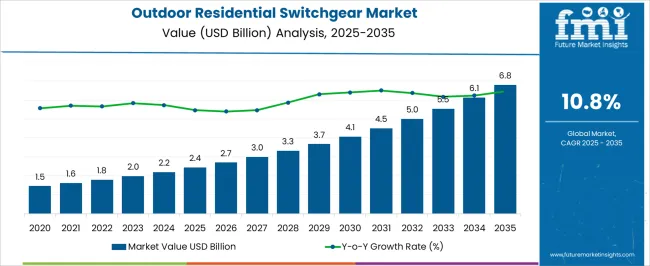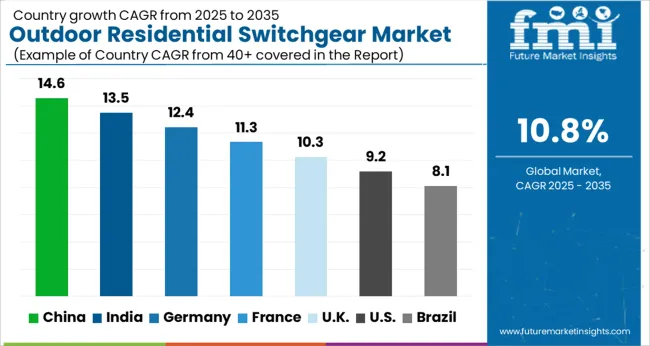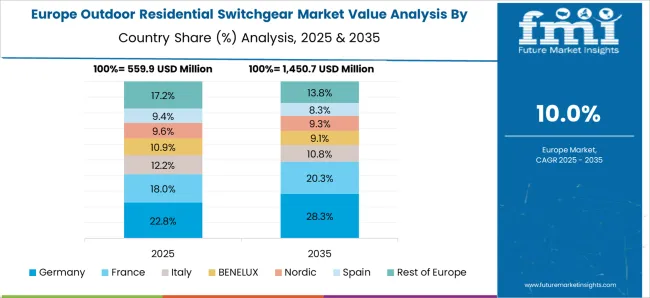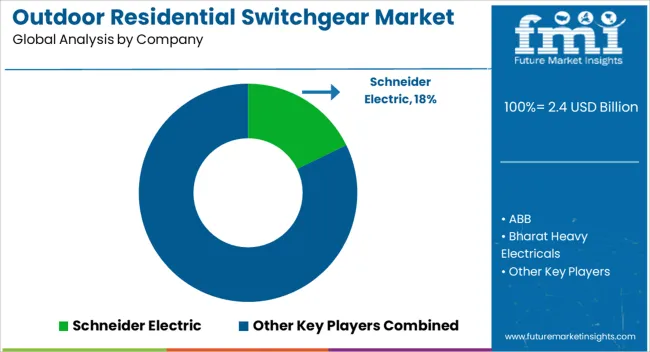The outdoor residential switchgear market is projected to grow from USD 2.4 billion in 2025 to USD 6.8 billion by 2035, achieving a CAGR of 10.8%. Over the first half of the period (2025 to 2030), the market will rise steadily from USD 2.4 billion to USD 4.1 billion, driven by increasing household electrification needs, grid modernization, and rising adoption of smart energy management systems.
This phase represents a growth multiplier of 1.71x over five years. The subsequent five years (2030 to 2035) will see the market advance from USD 4.1 billion to USD 6.8 billion, reflecting a 1.66x multiplier, supported by widespread integration of renewable energy and residential backup systems. Over the full 2025 to 2035 period, the market will post an overall 2.83x growth multiplier, underpinned by infrastructure upgrades in both developed and emerging economies.
Advancements in safety features, compact designs, and modular configurations will enhance consumer adoption rates. Energy decentralization trends and favorable regulatory frameworks promoting residential solar and battery systems will further boost the deployment of outdoor residential switchgear. With growing emphasis on electrical safety and operational reliability, manufacturers focusing on smart-enabled and weather-resistant units are expected to capture significant value in this USD 6.8 billion market by 2035.

| Metric | Value |
|---|---|
| Outdoor Residential Switchgear Market Estimated Value in (2025 E) | USD 2.4 billion |
| Outdoor Residential Switchgear Market Forecast Value in (2035 F) | USD 6.8 billion |
| Forecast CAGR (2025 to 2035) | 10.8% |
The outdoor residential switchgear market is expanding steadily due to increasing electricity demand from decentralized residential setups, smart grid infrastructure, and the integration of renewable energy sources. Investments in upgrading existing residential distribution networks, particularly in suburban and off-grid regions, are driving installation of compact, weather-resistant switchgear systems.
Emphasis on residential safety, outage prevention, and fault detection has also led to wider adoption of technologically advanced and remote-controllable switchgear units. Regulatory shifts favoring energy efficiency, load balancing, and grid modernization have further encouraged residential developers and local utilities to upgrade switchgear capacity.
With growing residential electrification in developing regions and the rising penetration of rooftop solar systems, long-term demand for robust and scalable outdoor switchgear is expected to remain strong.
The outdoor residential switchgear market is segmented by voltage, current, and geographic region. By voltage, the market is divided into medium and low categories. By current, it is classified into AC and DC. Geographically, the industry is divided into North America, Latin America, Western Europe, Eastern Europe, Balkan & Baltic Countries, Russia & Belarus, Central Asia, East Asia, South Asia & Pacific, and the Middle East & Africa.
The outdoor residential switchgear market is growing due to increased demand for efficient power distribution in residential areas. In 2024 and 2025, growth drivers include the rising need for reliable and safe electricity supply, particularly in smart homes and sustainable residential developments. Opportunities exist in expanding switchgear solutions for smart grids and renewable energy integration. Emerging trends focus on compact, modular designs and advanced protection features. However, high installation costs and regulatory challenges in different regions pose significant market restraints.
The major growth driver for the outdoor residential switchgear market is the increasing need for reliable and efficient power distribution in residential areas. In 2024 and 2025, the demand for uninterrupted electricity supply in modern homes drove the adoption of outdoor switchgear systems, particularly in high-density urban areas. As smart home technologies and energy-efficient systems gain traction, the need for integrated electrical solutions, including switchgear, has seen substantial growth. This shift toward stable, efficient power systems has fueled the market’s expansion.
Significant opportunities lie in the integration of outdoor switchgear systems with smart grids and renewable energy applications. In 2025, the growing demand for renewable energy sources, like solar and wind, in residential setups opened new avenues for switchgear manufacturers. Additionally, the rise of smart grids, where residential properties are increasingly equipped with advanced metering and monitoring systems, further contributed to the demand for reliable switchgear solutions. These innovations represent lucrative growth prospects for the outdoor residential switchgear market.
Emerging trends in the market include the demand for compact, modular switchgear designs that offer ease of installation and improved functionality. In 2024, manufacturers increasingly focused on developing space-saving solutions for residential properties with limited space. These modular designs allowed for customized power distribution setups, particularly in smart homes. Additionally, the integration of advanced protection features, such as overload and fault detection, became standard. These trends demonstrate the ongoing evolution toward more flexible, efficient, and user-friendly switchgear solutions in the residential sector.
Key market restraints include high installation costs and regulatory barriers. In 2024 and 2025, the upfront costs of outdoor residential switchgear systems, particularly in newly constructed homes or retrofitted properties, remained a challenge. Additionally, varying regulatory standards across different regions added complexity to the adoption process. Meeting local safety, performance, and environmental standards required significant investment in testing and certification, limiting adoption, particularly in price-sensitive markets. These constraints emphasize the need for cost-effective solutions that comply with regional regulations to foster wider market growth.

The global outdoor residential switchgear market is projected to grow at 10.8% CAGR from 2025 to 2035. China leads with 15% CAGR, driven by rapid urbanization, increasing demand for residential infrastructure, and a focus on modernizing the electrical grid with advanced switchgear solutions. India follows at 14%, supported by the expanding residential and commercial sectors, along with government initiatives to improve energy access in rural areas.
Germany records 12% CAGR, with strong demand for high-performance switchgear in the country’s growing renewable energy sector. The United Kingdom grows at 10%, while the United States posts 9%, reflecting steady demand for outdoor switchgear solutions driven by sustainable energy transitions and grid modernization. Asia-Pacific leads in growth due to industrial expansion, while Europe and North America emphasize technology upgrades and environmental compliance.
The outdoor residential switchgear market in China is forecasted to grow at 15% CAGR, driven by the country’s rapid urbanization, residential development, and increasing demand for electrical grid upgrades. As China continues to modernize its energy infrastructure, demand for high-quality switchgear solutions in residential buildings, including homes and apartment complexes, continues to rise. The government’s focus on renewable energy integration, as well as efforts to improve grid stability, accelerates market growth.
The outdoor residential switchgear market in India is projected to grow at 14% CAGR, fueled by the expansion of the residential and commercial sectors and government efforts to enhance energy access across urban and rural areas. The rising demand for reliable, safe, and energy-efficient switchgear in homes and apartment complexes drives market growth. Additionally, the government's focus on clean energy and smart grid development further boosts the demand for advanced outdoor residential switchgear solutions.

The outdoor residential switchgear market in Germany is expected to grow at 12% CAGR, driven by the country’s focus on renewable energy integration, grid modernization, and the expansion of electric vehicle infrastructure. As Germany continues its transition to cleaner energy, demand for advanced switchgear solutions in residential buildings and renewable energy installations increases. The market is further fueled by Germany’s commitment to sustainability and environmental compliance in electrical infrastructure projects.
The outdoor residential switchgear market in the United Kingdom is projected to grow at 10% CAGR, supported by strong demand from residential infrastructure development and the increasing need for energy-efficient solutions. The UK’s push towards renewable energy sources, grid stability, and carbon neutrality drives the adoption of outdoor residential switchgear solutions. Additionally, government incentives for sustainable construction and energy-efficient housing further fuel market growth.

The outdoor residential switchgear market in the United States is projected to grow at 9% CAGR, reflecting steady demand in mature markets with a focus on modernizing electrical infrastructure. The adoption of renewable energy sources, smart grids, and electric vehicles enhances the need for advanced outdoor switchgear solutions in residential buildings. Government incentives for clean energy projects and energy-efficient housing developments further stimulate market growth.

The outdoor residential switchgear market is characterized by the presence of global leaders and a growing pool of regional players focused on localized solutions. Schneider Electric holds a leading position with its wide portfolio of compact, energy-efficient, and modular switchgear products optimized for residential applications. Its strong global presence and sustainability-driven designs, including SF6-free eco-efficient units, continue to differentiate the brand in this segment.
ABB, Siemens, Eaton, and General Electric command substantial shares through comprehensive offerings that emphasize reliability, safety, and smart-grid integration. These companies are actively expanding their portfolios with digital switchgear solutions that integrate IoT-based monitoring, predictive maintenance, and automation features, aligning with the increasing demand for intelligent residential power infrastructure. Their focus on minimizing energy losses and delivering scalable systems supports adoption across both developed and emerging markets.
In contrast, emerging players such as CHINT Group, Bharat Heavy Electricals, Fuji Electric, Toshiba, Hyosung Heavy Industries, and Hitachi are targeting cost-sensitive regions with localized manufacturing and compliance-driven products. Their strategies center on offering compact, durable, and automation-ready units tailored to regional regulatory requirements and growing residential construction activity.
Competition is intensifying as established firms push eco-friendly and digital-first innovations while challengers leverage price competitiveness and regional agility. With residential electrification trends, EV charging integration, and renewable energy adoption accelerating, the competitive environment is expected to remain dynamic and innovation-driven.
| Item | Value |
|---|---|
| Quantitative Units | USD Billion |
| Voltage | Medium and Low |
| Current | AC and DC |
| Regions Covered | North America, Europe, Asia-Pacific, Latin America, Middle East & Africa |
| Country Covered | United States, Canada, Germany, France, United Kingdom, China, Japan, India, Brazil, South Africa |
| Key Companies Profiled | Schneider Electric, ABB, Bharat Heavy Electricals, CG Power and Industrial Solutions, CHINT Group, Eaton, Fuji Electric, General Electric, HD Hyundai Electric, Hitachi, Hyosung Heavy Industries, Lucy Group, Mitsubishi Electric, Ormazabal, Siemens, Skema, and Toshiba |
| Additional Attributes | Dollar sales by metal type and application, demand dynamics across automotive, construction, and manufacturing sectors, regional trends in recycled metal production and consumption, innovation in sorting and processing technologies, environmental impact of recycling practices, and emerging use cases in sustainable construction and high-performance materials. |
The global outdoor residential switchgear market is estimated to be valued at USD 2.4 billion in 2025.
The market size for the outdoor residential switchgear market is projected to reach USD 6.8 billion by 2035.
The outdoor residential switchgear market is expected to grow at a 10.8% CAGR between 2025 and 2035.
The key product types in outdoor residential switchgear market are medium and low.
In terms of current, ac segment to command 72.1% share in the outdoor residential switchgear market in 2025.






Our Research Products

The "Full Research Suite" delivers actionable market intel, deep dives on markets or technologies, so clients act faster, cut risk, and unlock growth.

The Leaderboard benchmarks and ranks top vendors, classifying them as Established Leaders, Leading Challengers, or Disruptors & Challengers.

Locates where complements amplify value and substitutes erode it, forecasting net impact by horizon

We deliver granular, decision-grade intel: market sizing, 5-year forecasts, pricing, adoption, usage, revenue, and operational KPIs—plus competitor tracking, regulation, and value chains—across 60 countries broadly.

Spot the shifts before they hit your P&L. We track inflection points, adoption curves, pricing moves, and ecosystem plays to show where demand is heading, why it is changing, and what to do next across high-growth markets and disruptive tech

Real-time reads of user behavior. We track shifting priorities, perceptions of today’s and next-gen services, and provider experience, then pace how fast tech moves from trial to adoption, blending buyer, consumer, and channel inputs with social signals (#WhySwitch, #UX).

Partner with our analyst team to build a custom report designed around your business priorities. From analysing market trends to assessing competitors or crafting bespoke datasets, we tailor insights to your needs.
Supplier Intelligence
Discovery & Profiling
Capacity & Footprint
Performance & Risk
Compliance & Governance
Commercial Readiness
Who Supplies Whom
Scorecards & Shortlists
Playbooks & Docs
Category Intelligence
Definition & Scope
Demand & Use Cases
Cost Drivers
Market Structure
Supply Chain Map
Trade & Policy
Operating Norms
Deliverables
Buyer Intelligence
Account Basics
Spend & Scope
Procurement Model
Vendor Requirements
Terms & Policies
Entry Strategy
Pain Points & Triggers
Outputs
Pricing Analysis
Benchmarks
Trends
Should-Cost
Indexation
Landed Cost
Commercial Terms
Deliverables
Brand Analysis
Positioning & Value Prop
Share & Presence
Customer Evidence
Go-to-Market
Digital & Reputation
Compliance & Trust
KPIs & Gaps
Outputs
Full Research Suite comprises of:
Market outlook & trends analysis
Interviews & case studies
Strategic recommendations
Vendor profiles & capabilities analysis
5-year forecasts
8 regions and 60+ country-level data splits
Market segment data splits
12 months of continuous data updates
DELIVERED AS:
PDF EXCEL ONLINE
AC Residential Switchgear Market Size and Share Forecast Outlook 2025 to 2035
Indoor Residential Switchgear Market Size and Share Forecast Outlook 2025 to 2035
Low Voltage Residential Switchgear Market Size and Share Forecast Outlook 2025 to 2035
Medium Voltage Residential Switchgear Market Size and Share Forecast Outlook 2025 to 2035
Outdoor Pet Backpack Market Size and Share Forecast Outlook 2025 to 2035
Outdoor Camping Toilet Market Size and Share Forecast Outlook 2025 to 2035
Switchgear for Data Centers Market Size and Share Forecast Outlook 2025 to 2035
Residential Generator Market Size and Share Forecast Outlook 2025 to 2035
Residential Energy-Efficient Technologies Market Size and Share Forecast Outlook 2025 to 2035
Outdoor Boundary Vacuum Load Switch Market Size and Share Forecast Outlook 2025 to 2035
Residential Interior Wood Doors Market Size and Share Forecast Outlook 2025 to 2035
Outdoor LED Lighting Market Size and Share Forecast Outlook 2025 to 2035
Outdoor Payment Terminal Market Size and Share Forecast Outlook 2025 to 2035
Residential Air-to-Air Heat Pump Market Size and Share Forecast Outlook 2025 to 2035
Residential Automatic Motor Starter Market Size and Share Forecast Outlook 2025 to 2035
Residential AMI Gas Meter Market Size and Share Forecast Outlook 2025 to 2035
Residential Vacuum Circuit Breaker Market Size and Share Forecast Outlook 2025 to 2035
Residential Solar Tracker Market Size and Share Forecast Outlook 2025 to 2035
Residential Non-metal Electrical Conduit Market Size and Share Forecast Outlook 2025 to 2035
Residential Carpet Roll Market Size and Share Forecast Outlook 2025 to 2035

Thank you!
You will receive an email from our Business Development Manager. Please be sure to check your SPAM/JUNK folder too.
Chat With
MaRIA